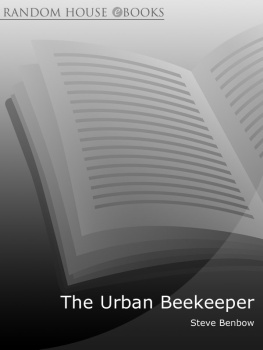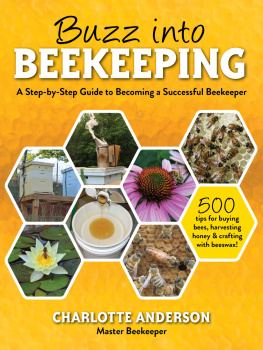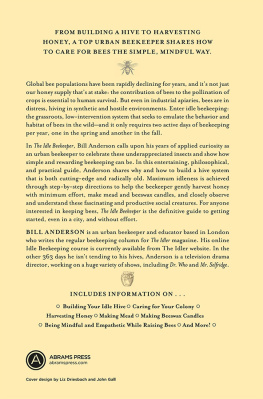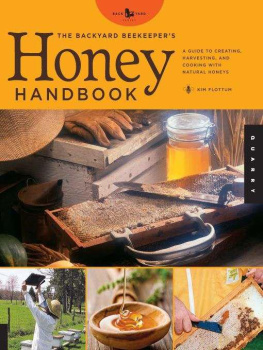

Text copyright 2014 by Megan Paska.
Photographs copyright 2014 by Alex Brown.
All rights reserved. No part of this book may be reproduced in any form without written permission from the publisher.
ISBN 978-1-4521-3038-5
The Library of Congress has cataloged the previous edition as follows:
ISBN 978-1-4521-0758-5
Designed by Suzanne LaGasa
Illustrations by Masako Kubo
The photographs on were shot on location at Brooklyn Grange.
Chronicle Books LLC
680 Second Street
San Francisco, California 94107
www.chroniclebooks.com
INTRODUCTION:
How a City Girl Got Stung

Sometimes when I stop to think about the fact that I am an urban apiaristmeaning people pay me to take care of beesit still seems a little crazy.
For one, I live in New York City, in its most populous borough, Brooklyn. Its noisy, its grimy, and, at first glance, it seems like everything is covered in either pavement or an apartment tower. The concrete jungle is not exactly the backdrop one imagines as a honeybee heaven. When I got my first batch of bees on a blustery Easter morningthe buzzing package headed for my Brooklyn rooftopI was skeptical that my new hobby made any sense. Would my bees starve? Would they get sick? Would they annoy my neighbors? But the real reason my current occupation is so strange is that for most of my life, I was afraid of bees. Terrified. When I think back to my first experience with the tiny, mighty European honeybeea.k.a. Apis melliferaI can say with certainty that it was not a Eureka! moment. Or at least it was not a good one. I was about six, and I was playing barefoot in a weedy field of clover and dandelion behind the apartment complex in Baltimore where I lived. I was jolted by three sudden pinpricks, which evolved into a searing, pulsating pain that engulfed my entire foot.
I ran home, crying and confused, and burst through my front door, red faced and hysterical. I didnt know what could have caused that sort of pain, but it was certainly something devilish. But my Grandma Dorothy calmly sat me down and pointed out the stingers, which I know so well today, still lodged in the top of my foot with the telltale venom sac of a honeybee still attached. With the blunt edge of a kitchen knife, she knowingly scraped them out and anointed my plump, red foot with baking soda paste. (Scrape; never pinch, she told me. Its the cardinal rule in removing a bee stinger, or else youll force more venom into your bloodstream.) In the end, my dramatic first meeting with the honeybee ended in three fatalitiesthe beesand a tender, fat foot. Grandma told me that it would hurt for a while, and she was right: It was the most traumatizing thing I had experienced thus far in my short life, and that day I swore that I would never again get anywhere near those ornery things as long as I lived.
But, two decades later, there I was in Brooklyn, ordering bees from a fledgling urban bee club and building a hive on the kitchen floor of my apartment. By that point, Id discovered that urban beekeepers were multiplying in France and the United Kingdom. And Id learned that bees in the city have just as good a chance as anywhere else to thrive. Urban trees and overgrown lots provide enough nectar and pollen from weeds like yellow sweet clover, curled blooms of gooseneck loostrife, or yellow tufts of goldenrod not just to sustain my bees throughout the seasons but to score me some of their surplus honey. My neighbors hardly notice the busy apiary situated on the rooftop above our heads and, in fact, are reminded of its presence there only when they are gifted small jars of bee goodness in the summertime. Thats Brooklyn honey, and, in case youre wondering, it is really good!
I get asked a lot: How did you decide to become a beekeeper? Truth be told, it took a few decades. Things started to change when I got a little older and began spending more time visiting my familys farm, a 450-acre parcel outside of Lynchburg, Virginia. Until I was a teenager, my mom, baby sister, and I would go to the farm every summer when school let out. It was always a total alien experience; I was a Baltimore city kid through and through, but this vast, quiet place with its verdure and its kindly people grew on me. I began to think of it as a second home.
My family in Virginia had held on to a tradition that us city kin had long since abandoned. They grew and raised a significant amount of what they cooked, and they really seemed to savor it when it came time to eat it. It didnt hurt that my Aunt Joanne was a great country cook: Most of the savory things she made were flavored with salty bacon fat rendered from the pigs the family had raised and sent off to be butchered and cured nearby. Jams and jellies were made right there in her kitchen, put up in jars, and kept in the cellar under her house until they were ready to eat. I had my first vine-ripe, homegrown tomato on an early trip to Virginia. It was shocking to mea kid who hated tomatoes that werent in the form of spaghetti sauce or ketchup. They were wonderfully flavorful and juicy and not at all mealy and bland like the ones topping the fast-food burgers I was used to. But at Aunt Joannes house, you could find them on the kitchen table at each meal, sliced and lightly salted. Id eat them sandwiched between two pieces of fresh baked bread with a little smear of smoky bacon grease. I never looked at a tomato the same way again. But even more important, the farm taught me to understand where my tomato came from and to realize that I was capable of making it, not just buying it.
A few years later, I signed the lease on my first house, a rustic limestone structure built for the sailmakers that worked in factories along the Jones Falls in Maryland. The house dated back to the 1840s, and it had three fireplaces and wooden plank floors. It was wonderfully old and dank. You could feel the spirits of generations of transplanted Appalachian mill workers emanating from the worn wood floors and plaster walls. But what I reveled in most was the sunny private backyard and the opportunity to grow food for real. I wanted more than just a couple of tomatoes and some herbs in containers; I wanted to stop buying substandard produce from supermarkets, save money, and be more like my Aunt Joanne. So I grew okra, lettuce, peas, peppers, summer and winter squash, tomatoes, and herbs in varieties that I had never seen or tasted before. I was surprised at how successful it was and how at ease I felt working outdoors.
Once I began harvesting vegetables, I had to figure out what to do with them. This was challenging: I still felt like an inexperienced cook, and after spending weeks coddling my kale as it was growing in the ground, I didnt want to ruin it. So I started relying on recipe books that my mother always had around but never really used. The Joy of Cooking, Fannie Farmer Cookbook... you know, old-school cookbooks. Id spent time as a child lying on the floor dreamily flipping through pages of these like they were teen magazines, and now I was finally putting them to use. And once I got comfortable with my old-school kitchen skills, I started to wing it.
What does all that have to do with bees? In the garden, Id started to notice that certain crops, like my butternuts, had different flowers. Male flowers with longer stalks didnt end up producing fruit, but the female flowers closer to the vine would wither and a small bulbthe start of a squash!would appear in their place. But, I noticed, this would only happen if an insect, maybe a bee, had visited a male flower first, coating themselves with the vibrant dust we call pollen before inadvertently transferring it to a female blossom. I started to pay attention to similar crops, the ones that rely on pollination to produce: tomatoes, peppers, eggplant, berries, cucumbers, melons.... As a garden-obsessed adult, Id finally accepted that bees werent actually vicious at all, largely because I hadnt been stung since that first time. The bees kept to themselves, resolutely bound to their eternal task of finding food. I stayed out of their way; they stayed out of mine. As a result, I got over my bee anxiety, and I could appreciate them from a distance. And I began to wonder, where have all the honeybees gone? Why am I not seeing as many as I remember running away from as a kid?
Next page










